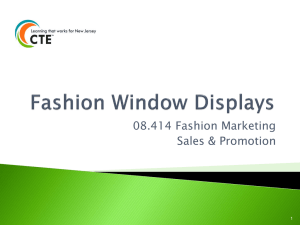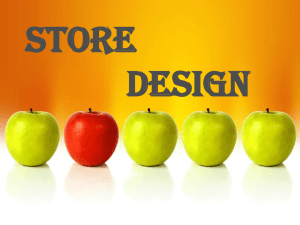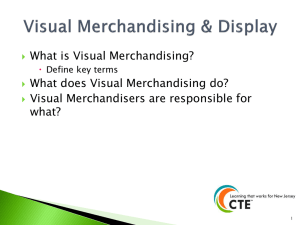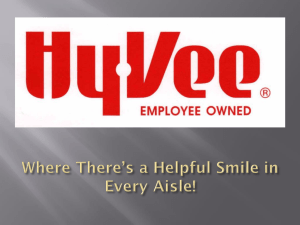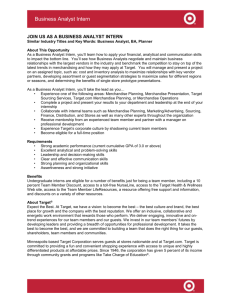Jagannath Institute of Management Sciences Lajpat Nagar BID V
advertisement
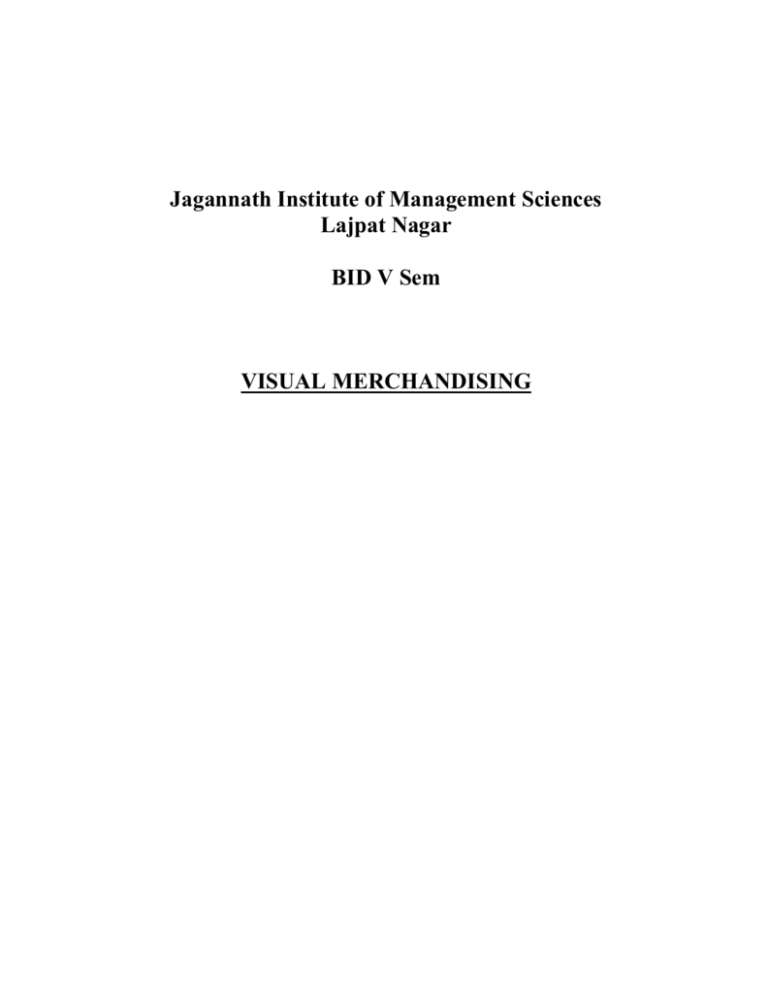
Jagannath Institute of Management Sciences Lajpat Nagar BID V Sem VISUAL MERCHANDISING VISUAL MERCHANDISING UNIT 1 Definition: Visual merchandise is the presentation of a store and its merchandise in such a manner that will attract the attention of potential customers. It involves decorating the store keeping the interior presentation the same as what is promised on the outside. The end purpose of visual merchandise is to aid in making a sale. Visual merchandise presents an image of whom or what the shopper can be when using the merchandise displayed. It enables in converting a walk by shopper into a walk-in customer. Visual merchandise requires a combination of skills including creativity, artistic knowledge and understanding of store design. Color is a big attraction point in converting potential shoppers into customers. Visual Merchandising - Encompasses all of the physical elements that merchandisers use to project an image to customers. Storefront - This includes the store’s name, logo, banners, windows, and the exterior design. Marquee - An architectural canopy that extends over a store’s entrance. Store Layout-refers to the way a store uses floor space to promote sales and serve customers. Fixtures - Permanent or movable store furnishings that hold and display merchandise. P.O.P.(Point of Purchase) - Consumer sales promotion device with bold graphics and signage that hold, display, or dispense products. Kiosk - Large displays that are typically 4 ft high, have immediate product availability, and are seen free standing in malls as well as within a store Selling space is the most important part of a store and therefore, efforts to utilize each square foot will help to maximize sales. One proven way to do this is through interior displays that effectively show merchandise to the customer. When planning interior displays, remember that the theme and image presented on the exterior must be carried throughout the interior of the store to provide consistency for the customer. Promotion and advertising dollars are less effective or even wasted when efforts are not made within the store to effectively merchandise the products. Well-designed displays and in-store promotions are essential for a consistent theme and to help the customer find advertised items. Before designing good displays, answer the following questions: 1. What is the store’s image? Select an image to present to the public. The customer will identify a certain look with a store and expect that look to be carried through- out the business, be it trendy, elegant, off-price or discount. Do not mix images within one store, it will only confuse the customers. 2. What type of customer is being attracted? Use a display that reflects the targeted consumer. A display that works well in one community may be ineffective in another community 3.What is the concept of the merchandise to be presented in the display? Display and highlight the merchandise, do not merchandise an attractive display. Items should be displayed as they are meant to be used or worn. If formal wear is combined with day wear and kitchen accessories, the consumer is confused and sales are lost. 4. Where is the display going to be set up and how will the location determine the design? There are many types of locations for display in every store: windows, walls, cases, gondolas or islands. The principles of display should help make the location work for the display. 5. Why is this merchandise beinG presented Principles of Design Used in Visual Merchandising Balance :Balance involves the equilibrium and weight of elements between two sides of a display. Balance is based on a theory of equals. Two types of balance include: 1. Traditional or symmetrical balance is large on one side and large on the other. This can be effective where expensive and quality merchandise is being presented. 2. Informal or asymmetrical balance creates flow or rhythm and a feeling of excitement. The two sides of the display appear to be of equal weight, but they are not replicas of each other. Something large can be balanced by several small items or an expanse of empty space, a bright color or a shot of lights. Several soft colors in a large space can be balanced by one bright color because the intensity of the bright color will compensate for its small size When planning a display, consider the following points concerning balance: • If colors are too bright, they will overwhelm pastels. • If several small objects are more exciting than the large object, they will overpower the large item. • A large expanse of empty space will call attention to a single object placed within it. • If an item is placed at an angle or to one side (off-center), the space on either side of that piece becomes important. • If an object is centered, the empty space loses importance because its shape is predictable and therefore has less recognition as its own element Emphasis Emphasis is the point of initial eye contact. From this spot all other eye movements flow. Emphasis is therefore the formulation of a focal point, with all else in the display subordinate. There should be emphasis in all displays. This can be by virtue of the focal point’s size, color or position. The merchandise is the focal point in a majority of displays. When planning a display, consider the following points concerning emphasis: • A display needs to emphasize a theme or mood, such as the use of sports equipment, work equipment or leisure equipment set up in a lifelike situation. Themes may also depict seasons, anniversaries, celebrations, holidays and other special store events. All elements in a display must then reinforce one other and emphasize the mood created. Proportion Proportion is the ratio of the parts to the whole display. It is a comparative relationship of distances, sizes, amounts, degrees or parts. Each item may look normal when isolated, but if it is inconsistent in area or dimension with neighboring items, it seems out of proportion. Each piece of merchandise must be considered in relationship to all the other merchandise When planning a display, consider the following points concerning proportion: • Do not use all large objects, because there is nothing to break the monotony and sameness of that large feeling. • Adding an odd number of smaller, related items to large pieces creates more interest and balance. • Proportions take on more meaning when items define one another. For example the size of a dinosaur is defined when it is standing next to a two story house. • Proportion and balance can best be accomplished when articles within the display play off each other through their size, shape and color. • Ratio of merchandise to space is critical: > Each piece of merchandise must be considered in relation to others. > The ratio of props and show cards to merchandise must be in proportion to avoid the appearance of stressing or selling your props rather than your merchandise. > Each object should not be too large or too small, nor too heavy or too light in propportion to other items in display areas. Rhythm Rhythm or flow involves the measurement of organized movement; a self-contained movement from object to object, background to foreground, and/or side to side. The rhythm in a display should lead the viewer’s eye from the dominant object to the subordinated object(s) or from the primary presentation of the grouping down to the arrangement of accessories or alternate parts of the display. Rhythm may be broken-up or continuous; clearly stated or subtly suggested; repeated or vaguely similar. The initial pattern or design when repeated makes more of an impression on the viewer because it provides a continuous beat and completion, which is satisfying to the viewer. Rhythm entails an arrangement of organized motion and does not necessarily need repetition. However, it does gain impact from repetition.A flow exists if the eye travels from one area of a display to another, covering the entire display. The eye should travel easily through the entire design. For example, if a very tall object, such as a mannequin, is placed next to several short baskets, there may be proportion but no flow. If dried or silk flowers or reeds are placed in the baskets (one and one-half times the height of the baskets), the height of the smaller objects is raised so the eye flows easily from the head and neckline of the mannequin to the baskets. A display can lead the eye with color, repetition, shadows created by light placement, lettering or texture. When planning a display nsider the following points concerning rhythm: • English-reading people read from left to right. A left to right reading should be created in the display. • Use elements that mean something together and relate to the merchandise. • Create a pattern through the use of light and dark, either with color or light. Overlapping of objects placed together in the display area can prevent the blank space that could exist with an even number of items in a display. Overlapping is one of the most effective tools for creating good flow. • It is usually recommended to use an odd number of items when displaying multiples. • Use a fabric or color that unifies the theme. • Use props that are repetitious either in form or theme. • Use the technique of flying merchandise to create flow. Harmony Harmony is a coordinating umbrella principle that can cover and incorporate every other principle. Harmony is agreement in feeling and consistency in mood; i.e., the feeling that all parts of a display relate to each other and to the whole display. Without harmony, the observer is uncomfortable and will not be enticed to purchase merchandise. Three forms of harmony (functional, structural and decorative) must be in agreement in a display. Functional harmony deals with how something works physically, which means it must be realistic and must work. An example is a kitchen counter used in a display that is the appropriate height and depth for working. Structural harmony is correctly fitting together all the pieces; merchandise should not be out of place in the display. For example, an electrical appliance is not structurally consistent in an outdoor or camping display. A good window display may have pots and pans, fishing gear and outdoor furniture all mixed together because these items truly would be used on a camping trip; hence a camping theme is carried out. All the merchandise is brought together as part of the trip and harmony would be created or a mood would be set. Decorative harmony includes the parts of a display that are included only for decorative purposes. If an atmosphere of spring is being developed, butterflies and/or flowers may be used as props. These items are attractive and add to the theme Color Color contributes significantly to people’s impression of a display, as well as a store’s overall appearance. Color in a display can catch the eye and make people pause and look. The color combinations of the ceiling, walls, floor covering and the overall decor can affect the atmosphere of a store. Changing the color scheme can change people’s attitudes and perceptions of a store, and can increase (or decrease) business. Color can change the shape and add interest to a dull room, and can direct attention toward a specific object or away from problem areas. People tend to respond a certain way to different colors; these responses are outlined in the chart on the following page Warm colors (red, yellow, orange and colors with red or yellow hues such as yellowgreen, beige, peach, brown and orange-red) are stimulating and cheery. They make a room feel warm and intimate. Warm colors make a room seem smaller while making objects in the room appear larger. A warm color on the end walls of a long narrow room will appear to shorten the room. Blue, green, violet and colors containing blue, such as blue-green and violet-blue, are cool colors. These help create a relaxing atmosphere. Rooms decorated primarily in cool colors tend to appear larger and more spacious. Cool colors are especially pleasing in smaller rooms. Lighting Lighting is essential in calling attention to merchandise in a display. A shopper’s eye is drawn automatically to the brightest item or area. Lighting treatment may be used to draw attention to part of the display area, a specific item in the display, or to coordinate parts of the total display area. Lighting can also be used to direct shoppers through the store, attracting them to various displays along the way. Because of this tendency to follow a lighted path, display lights should be two to five times stronger than lighting in other parts of the store. Techniques Visual merchandising builds upon or augments the retail design of a store. It is one of the final stages in setting out a store in a way customers find attractive and appealing. Many elements can be used by visual merchandisers in creating displays including color,[6] lighting, space, product information, sensory inputs (such as smell, touch, and sound), as well as technologies such as digital displays and interactive installations. As methods of visual merchandising can be used color and style, symmetry and rhythm, face and side presentation etc. End Caps Display sales items on end caps, fixtures at the end of aisles and facing the main aisles of your store. These displays will grab the attention of customers as they wander through the store. A common end-cap technique is cross-merchandising, where related items are grouped together to encourage add-on sales. An example of this would be when a grocery store displays spaghetti sauce with pasta products. Micromerchandising Draw attention to certain products in an otherwise mundane middle section of a long aisle with micromerchandising. Accomplish this by using a different type of shelving or fixture than the rest of the aisle or by implementing a different color scheme. Customers who would normally walk by the section without taking notice may be intrigued enough by the change of scenery to stop for further investigation. Theme Displays Use theme displays as a method of cross-merchandising by building displays around a special event or holiday. For example, grocers often build large displays around a football theme for the Super Bowl using a wide variety of snack items. More creative merchandisers might take it a step further by building a mini football stadium with cases of soda and displaying a variety of tailgating products in the area around it. ELEMENTS OF DESIGN: Line: The first and most basic element of design is that of the line. In drawing, a line is the stroke of the pen or pencil but in graphic design, it’s any two connected points. Lines are useful for dividing space and drawing the eye to a specific location. For example, think about how a magazine uses lines to separate content, headlines and side panels. Shape:Shapes, geometric or organic, add interest. Shapes are defined by boundaries, such as a lines or color, and they are often used to emphasize a portion of the page. Everything is ultimately a shape, so you must always think in terms of how the various elements of your design are creating shapes, and how those shapes are interacting. Space:Negative space is one of the most commonly underutilized and misunderstood aspects of designing for the page. The parts of the site that are left blank, whether that’s white or some other color, help to create an overall image. Use negative space to create shapes as you would any other element. Texture:It’s counter-intuitive to think about texture when the piece isn’t ever going to be touched. Websites and graphic design do rely on the look and impression of texture on the screen, however. Textures can create a more three-dimensional appearance on this two-dimensional surface. It also helps build an immersive world. UNIT 2 DISPLAY WINODW Various types of window display areas are used in planning and building a storefront. They are elevated, elevator, raised or ramped, lobby, shadow box, corner, island or kiosk, open-back, semi closed-back, and closed-back Almost all types of windows have the drawback of glare andreflections that detract from the merchandise. Many stores use tinted glass to reduce reflection and sun damage. However,tinted glass has the effect of distorting the true color of them erchandise. Lighter backgrounds tend to play down the glare. Windows that are set in, angled, or curved also reduce glare;however, space is often lost when these techniques are used. A nice touch to reduce glare is the exterior awning, which can present the store name as well as lend color and atmosphere to the store or the shopping area. 1. Closed Windows – large glass panel at the front and solid wall at the back.Photo: ck Ha rv 2. Semi-closed Windows – large glass panel at the front and half-covered at the back so that the inside of the store is partially visible. Photo: 3. Open-back Windows – large glass panel at the front and no wall at the back 4. Open Window (or No Window) – no glass panel and no solid wall. 5. Elevated Windows – it can either be closed or open window that is located in a higher level. 6. Corner Windows – windows that are located at the corner of the building and are seen from two directions. 7. Island Windows – these are the stand-alone windows that are often located at the lobby of a big store. Photo: 8. Shadow Boxes – small box-like windows that are usually used for jewelry and cosmetics displays. UNIT 3 . STORE DESIGN : The main and important functional aspects of exterior design are customers visibility, store security and potential efficiency to fulfill customer requirement. The key elements which are important in any store is marquee, entrance area, windows, danglers, banners, canopies and lights Types of Store front • Arcade • Straight • Angled • Circled ARCADE-STORE FRONT • Arcade fronts are spacious • They allow the window merchandise on both the side of main door • These are more relaxing to the shopper and often are with concave or slanted panes of glass and beautifully decorated windows. STRAIGHT-STORE FRONT * This type of fronts parallels the side walk, with its monotony broken by entrances, * The entrance may be recessed into the main floor area, but all the lines are identical. ANGLED-STORE FRONT • Angled front is more similar to straight front, but the monotony is relieved by angles away from the side walk contour. • The designs of the doors or windows in an angled-front store may be asymmetrical or symmetrical. CIRCULAR-STORE FRONT • Circular front is more similar to straight front, but the monotony is on circular line. • The designs of the doors or windows in an curved front store may be asymmetrical or symmetrical. Types of Displays Island displays :Island displays are physical presentations of merchandise that can be accessed from any direction. A display of this type is usually situated in an open area of a retail establishment, such as near the entry to the store or in one of the larger aisles. Many merchants make use of an island display to call attention to items that have just arrived, or are currently on sale. Generally, the items included in the display will be related in some manner, thus creating a more compelling presentation. As a structure showing goods in the best possible position within the store, a carefully designed island display can be an effective selling tool. Unlike other types of displays, which provide views from one to three sides, the merchandise exhibit using the island presentation concept must be visually appealing from all directions. When executed properly, consumers are attracted to the display, and are more likely to linger longer than with a simple shelf display. Since catching and holding the attention of consumers is essential to making sales, the island display increases the chances of selling merchandise that would otherwise go unnoticed on store shelves. Corner Display : The comer window faces two streets that are perpendicular to each other. It is a window with a double exposure and double traffic. The corner window may be the sale display showcase for a store with an entrance near the corner of a street, or it may be the end of a run of windows. Usually, this window will have two adjacent panes of glass meeting at right angles. The back may be open or closed. Most stores convert this type of window into a triangular plan. The two glass fronts are the “legs” of the triangle and the long back wall is the “hypotenuse.” The space that is cut off from view becomes valuable storage space. Because the two windows are at right angles to each other, the viewer can almost always see the overhead and side lighting-as well as a view of other stores and signs beyond the display area. Customers can find themselves distracted by viewers looking in from the other side of the window and by mirrored backgrounds that reflect traffic lights and the signs from other stores. These are often considered the most important areas of any store frontage. They are the central viewing point of converging traffic and, consequently, the best merchandising areas. The average pedestrian will notice a corner window and its contents much more readily than a side street window ARCADE WINDOW DISPLAY :Arcade window display there are set back doors or entrances thereby increasing the size of display window, stores with limited frontage and merchandising philosophy requires a large window display space get benefited from such a design. Wall Display: Wall displays can take several different forms: face-outs above barred merchandise, merchandise displayed on a grid or a ledgedisplay above barred merchandise with face-outs on either side (optional). Guidelines for Merchandise Walls Sales associates who will be involved in setting up a wall or floor display should have certain criteria to follow to insure a proper merchandise presentation. 1. Follow the company placement of merchandise. plan-o-gram for proper 2. Colorize merchandise according to the store’s color chart. 3. Make certain that proper signage or toppers are used. 4. Hang all barred merchandise facing the front of the store. 5. If double-hanging two different classifications of Innovative wall systems can have a huge impact on retail sales.Wall displays are one of the largest display areas in a store. So while remodeling or updating retail store, perimeter wall treatment should be always kept in mind. Counter Display These sell merchandise more readily than do shelf displays,because they are located in front of the stock areas, bringing the goods nearer to the customer and allowing the customer to touch the merchandise. Square and rectangular shapes are the usual design for counters and cases. However, rounded, oval, and surrealistically shaped counters not only ease the flow of traffic through a store, they appear less regimented and do not present hazardous sharp edges to the customer. They are a pleasant change from the square design. . . Visual Merchandising Unit 4 Kiosk Design/Mobile Display Kiosks are freestanding units located throughout the shopping Malls,Terminals where ceilings and floors are in place,and as temporary in-line tenants along the concourse. The Kiosk is designed to enhance the opportunities to provide quick food and retail offerings to patrons with limited time during transit. The kiosk is a self-contained unit. Kiosks occupy prominent locations throughout the mall common area and have a significant impact on customer perception. Open floor plans that allow customers to walk through the kiosk design are highly recommended. Open layouts are more engaging to shoppers and add interest to the common area shopping experience. Health & Beauty and/or demonstration products work better in an open floor plan Kiosk Design Guidelines The kiosk design must be an open, low-profile concept (no overhead structure) without obstructing sight lines through the mall and to the stores adjacent and beyond Standard size of kiosk may not exceed 10’ x 10’ unless otherwise depicted on the lease document tables, seating and POS stations) must be wholly contained within leased footprint. maximum projection of any surface, cabinet, display, seating or signage cannot exceed the dimensions of the Tenant’s leased area. A minimum of 10’ clearance is required on all sides of the kiosk, unless built into a custom a -line counter heights may not exceed 42” above the floor. No inline storefront. over any Cabinet and countertop must have a color scheme that complements the mall interior; ideally wood tones, earth tones, or subtle colors. Primary and Secondary colors (such as Red, Blue, Yellow, Green, Orange, Violet ) may not be used as the prevailing color of any fixture The back of the cabinets must be finished, enclosed, and compliment the cabinet Seating/chairs need to be inside the kiosk. They must match the high quality of the kiosk construction and not damage the floor. Cabinets are not permitted to be affixed or attached to the mall floor. Incorporate concealed trash receptacles into the design that are not visible to the KIOSK SECURITY AND STORAGE and not visible to the public. Storage must be lockable and hidden from view to the public. KIOSK PLUMBING/ FOOD KIOSKS All plumbing connections must be fully concealed and all fixtures, piping and equipment must be contained within the retailer’s premises. construction. Penetrations must be sealed watertight. -producing kiosks may require additional ventilation at retailer’s expense. EXHIBITION DISPLAY Exhibition design is a collaborative process, integrating the disciplines of architecture, landscape architecture, graphic design,audiovisual engineering, digital media, lighting, interior design and content development to develop an audience experience that interprets information, involves and engages a user and influences their understanding of a subject.Throughout the planning and design process, exhibit designers work closely with graphic designers, content specialists, architects, fabricators, technical specialists, audiovisual experts, and, in the case of museums and other mission-based institutions, stakeholders like community members, government agencies and other partner organizations. TYPES OF DISPLAY BOOTHS Linear Booth Linear Booths, also called “in-line” booths, are generally arranged in a straight line and have neighboring exhibitors on their immediate right and left, leaving only one side exposed to the Corner Booth A Corner Booth is a Linear Booth at the end of a series of in-line booths with exposure to intersecting aisles on two sides. All other guidelines for Linear Booths apply. Perimeter Booth A Perimeter Booth is a Linear Booth that backs to an outside wall of the exhibit facility rather than to another exhibit. End-cap Booth An End-cap configuration is essentially an in-line (linear) booth placed in the position of a Peninsula or Split Island. For shows that have Line-of-Sight rules and not cubic content, this configuration must follow the dimensions below. For shows that have cubic content rules, the space may be used without restriction. Peninsula Booth A Peninsula Booth is exposed to aisles on three sides, and comprised of a minimum of four booths. There are two types of Peninsula Booths: (a) one which backs to Linear Booths, and (b) one which backs to another Peninsula Booth and is referred to as a “Split Island Booth.” Island Booth An Island Booth is any size booth exposed to aisles on all four sides DISPLAY BASICS Simplify your exhibition area – Be selective with objects on display. It is not necessary (and not advisable) to have every item in your collection on display. Tell the story – Does the display emphasise the most important aspects of the story or object? Does it grab you? An effective display technique is to follow a planned scheme which systematically outlines the exhibitions story line. Explain the Object – Is the display easy to understand? Always try to show an artefact so that its function is apparent. Information – Is the text easy to read? Design and Aesthetics – Does the spatial relationship between the items help the display? It should be obvious at a glance which parts of the display are related and which are not and how labels relate to objects. Begin designing the layout of the exhibition well before it is scheduled to take place. With this in mind think about how you can ‘set the scene’ or introduce the exhibition. A different coloured wall featuring the title of the exhibition and any sponsor logos, provides an introduction for the viewer and can be used to orient them into the exhibition space. Canopies and Ceilings Canopies, including ceilings, umbrellas and canopy frames, can be either decorative or functional (such as to shade computer monitors from ambient light or to allow for hanging products). Canopies for Linear or Perimeter Booths should comply with Line-of-Sight requirements. Most exhibitions and events rules allow for Hanging Signs and Graphics in all standard Peninsula and Island Booths, usually to a maximum height range of 16ft to 20ft (4.88m to 6.10m) from the top of the sign, or as determined by the show organizer. End-cap Booths do not qualify for Hanging Signs and Graphics. The distance is measured from the floor to the top of the sign. Whether suspended from above, or supported from below, they should comply with all ordinary use-of-space requirements. For example, the highest point of any sign should not exceed the maximum allowable height for the booth type LIGHTING No exhibit – especially fabric, a painting, drawing, print or original photograph should be placed where it is in direct sunlight at any time of the day. Efforts should be made to keep ambient lighting subdued with any windows near exhibits being blocked out or fitted with UV filtering screens for the duration of the display. Recommended light levels for specific objects during display can be obtained Check the lighting of an exhibition. Walk through the space, looking for shadows and any points that may shine into the visitors’ faces. It is always best to light works hanging on walls from an angle, positioning spotlights so that they pan over several exhibits.. UNIT 5 Show Room Display STORE LAYOUT Planning a layout for the store's interior is the first step in designing the store's interior Well-planned retail store layout allows a retailer to maximize the sales for each square foot of the allocated selling space within the store .Store layouts generally show the size and location of each department, any permanent structures, fixture locations and customer traffic patterns.Managing space is the first and foremost concern of almost every retailer, when it comes to designing the store's interior. Space is always an expensive and scarce resource. Retailers always try to maximize the return on sales per square foot. Objectives of a Store Layout There are certain objectives to attain which the retailers design the store layout. Some of main objectives can be put together as under: 1. To guide the customer around the store and entice increased purchases. 2. To create balance between sales and shopping space. 3. To create effective merchandise presentation. 1. Use multi-levels to provide a sense of variety. Selecting a Layout The basic arrangement of the selling floor is of primary importance, because it affects all other design decisions. Each type of layout has inherent strengths and weaknesses resulting from the traffic flow patterns they create. With changing formats and increasingly sophisticated store design research and techniques, retailers have been experimenting with many combinations of these plans. Layouts may be categorized intothree basic types: •Grid •Free flow •Loop/boutique GRID LAYOUTS A linear design for a selling floor where fixtures are arranged to form vertical and horizontal aisles throughout the store. Supermarkets, discounters, grocery, drug store and other convenience –oriented retailers, typically use it. This layout is done for more of the store’s convenience and the need to get a lot of product out on display. Advantages The basic advantages of using this kind of layout can be summed up as under: 1. It is efficient in terms of space use 2. Allows orderly stocking 3. Helps shoppers see a great number of items easily 4. Is simple and predictable to navigate 2. Efficient to maintain. 6. In a self-service format, this arrangement permits customers to shop in a quick, routine manner. 7. Strategic location of departments ensures that customers are drawn through the store and exposed to all merchandise categories. 8. Simplify the inventory maintenance. Disadvantages 1. The psychological effect on customers is one of feeling constrained and rushed, which reduces the time they spend browsing. 2. Not aesthetically pleasing. 3. Contains long gondolas of merchandise and aisles in a repetitive pattern, which creates monotonous effect that makes the customers feel bored after a certain time. It is not necessarily convenient for all consumers or the most effective selling approach. Certainly the main aisles will get lots of exposure, but the secondary aisles are often over looked and as a result sales are missed LOOP OR BOUTIQUE OR RACETRACK LAYOUTS: It exposes shoppers to a great deal of merchandise as they follow a perimeter traffic aisle with departments on the right and left of the circular, square, rectangular or oval racetrack. This layout divides the selling floor into shops within the store. This layout is employed in a discount or a department store. Advantages This layout exposes shoppers to a great deal of merchandise. It forces the customer to visit multiple departments as they pass through. This loop effect facilitates impulse buying. The newest merchandise is prominently displayed on these main aisles. Overhead directional signs and departmental graphics provide visual cues to the location of other departments, helping shoppers while shopping Construction, interior design and security costs are substantial, however. FREE-FLOW LAYOUTS It is an asymmetrical arrangement of merchandise that encourages an unstructured traffic flow. It is mainly used in specialty stores and within departments of department stores that emphasize mainly on ambiance and personal selling. This layout is the most flexible of the three plans. Advantages The main advantages of this layout are: It does not restrict the customers who do more browsing and unplanned purchasing. It also enhances interior design, as the individual departments are more easily distinguished. Tends to provide a more relaxed atmosphere. Personal selling is emphasized. Disadvantages The major disadvantages of this layout can be summed up as under: Its main weakness lies in the inefficient use of space and customer disorientation. Also requires higher labor and security expenditures. Lends itself to higher rates of theft because of blocked vision. Setup is expensive because the setup is custom made. Critical factor is providing enough room between fixtures to allow traffic to flow smoothly. It has selling fixtures arranged in loosely grouped, informal formations. Designers can use various combinations of the three layouts to increase flexibility or improve traffic flow. This practice is prevalent in multilevel stores and large, power assortment formats. A combination of formats may improve productivity as well as aesthetics and visual effectiveness. The other ways of store layouts can be discussed as under: SOFT AISLE LAYOUT This layout treats merchandised walls as some of the most important sales generators in the store. Floor fixtures are arranged into groups with a 5-foot aisle along merchandised wall sections. Encourages customers to shop the walls and move easily around the store. MINIMAL FLOOR LAYOUT Almost gallery-like in its simplicity, shows small selections of handcrafted or very exclusive merchandise. This layout is used in very high-end retail stores with designer merchandise. The products are presented dramatically on the walls of the store much like the art objects- with a minimal use of selling fixtures on the floor.It allows for wide-open spaces in the center of the store. SPACE PLANING DIVISION OF MERCHANDISE BY DEPARTMENT Merchandise is organized into groupings or classifications for the purpose of store layout and design. The creation of the various merchandise departments should be based on a logical plan that allows customers to locate desired items and make comparisons. Criteria used to divide merchandise by departments are: Function or usage – This includes sporting goods, kitchen appliances, home entertainment products etc. Customer purchase motive Impulse items, Diet foods etc. Price points – Bargain, moderate, and better dresses. Vendor identification – Giorgio Armani, Gucci etc. Storage and display considerations – frozen foods, dairy products, etc. Target Audience – men’s, women’s and children’s clothing. Allocation of Selling Space When designing a store layout, it is important to have a clear analysis of the yearly sales and gross margin contributed by each merchandise grouping. Naturally those with the highest return per square foot of selling space will have contributed the most to the business. Every retailer should plan on allocating space to also highly appealing. Merchandise located in the primary (main) traffic aisles will receive more customer exposure and less in the secondary (other) aisles. A higher level of customer exposure will occur at the junction of two or more primary aisles. Certainly the performance of any merchandise group will improve if it is moved to a prime location. However, do not waste valuable selling space by assigning it to merchandise that will not provide adequate gross margin .
